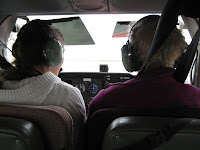 My girlfriend, Liz, got back from a semester in Ireland a few days ago and for her belated birthday present I took her flying. I e-mailed Iris Critchell (who I still have to write a "People I'm Glad to Know" post about...) asking if she would be willing to take us for a short flight on Saturday because Liz couldn't participate in the flight lab in her Flight Mechanics class. She agreed and asked what Liz wanted to do. After a while of that we decided to meet at 13:30 on Saturday and go for a spin in "42-Golf"; one of the Cessna 172's she flew for the Bates Program. The Cessna 172 is one of the most stable aircraft you'll find and Iris delighted in explaining the how and why of the aircraft's responses to us because we both understood a lot of what she was talking about.
My girlfriend, Liz, got back from a semester in Ireland a few days ago and for her belated birthday present I took her flying. I e-mailed Iris Critchell (who I still have to write a "People I'm Glad to Know" post about...) asking if she would be willing to take us for a short flight on Saturday because Liz couldn't participate in the flight lab in her Flight Mechanics class. She agreed and asked what Liz wanted to do. After a while of that we decided to meet at 13:30 on Saturday and go for a spin in "42-Golf"; one of the Cessna 172's she flew for the Bates Program. The Cessna 172 is one of the most stable aircraft you'll find and Iris delighted in explaining the how and why of the aircraft's responses to us because we both understood a lot of what she was talking about.
One of the new things that I learned was adverse yaw. In the aero world, the three rotational movements are called "pitch" (tipping up or down), "roll" (rolling side-to-side), and "yaw" (pivoting left and right). When you use the rudder to induce yaw, one wing is travelling faster through the air than the other which provides it with more lift. That additional lift induces a roll. However, when you use the alierons to create roll, the change in lift and drag across the wingspan will induce yaw counter to the turn. This phenomenon is called "adverse yaw" and is prevented by applying rudder into the turn as you roll.

Iris, being a flight instructor, was able to put us (one at a time) into the left seat and let us actually fly the plane once she'd gotten us into the air. Among the things that she showed us were steep-bank turns, low-power (and thus slow) flight control, and stalls. We also got to see how the plane reacted to flight conditions it didn't like -- we gave it a sharp tug to increase or decrease pitch and then took our hands off the controls and let the plane sort itself out over the course of the two oscillations for which it had been rated to do so. After we flew around for a while and learned more about flying in an hour than we had ever known before she took us back down and we headed back to Mudd.

Iris mentioned that when a new flight instructor is being tested for certification, it's an immediate fail if the trainee instructor ever stops talking. Perhaps that's why she'll talk your ear off.
~KMarsh




No comments:
Post a Comment